Introduction

In many of our lens reviews we talk about certain kinds of aberrations, so this article shall give you an overview of typical lens aberrations, tell you in what lenses to encounter them and how to cope with them.
Last Update: January 2023
Contents
Distortion
Description: Straight lines in the picture are not straight but curved or bent.
Common problem in: zoom lenses and wide angle primes
Solution: “uniform” barrel or pincushion distortion can be easily corrected. For complex/wavy distortion though, lens correction profiles are mandatory, but not every correction profile works perfectly at every focusing distance.
You can also have a look at this article to find out how to create your own correction profiles for Lightroom/Photoshop.
Trivia: for today’s digital photography many lens manufacturers decided to correct this in post processing
Field curvature
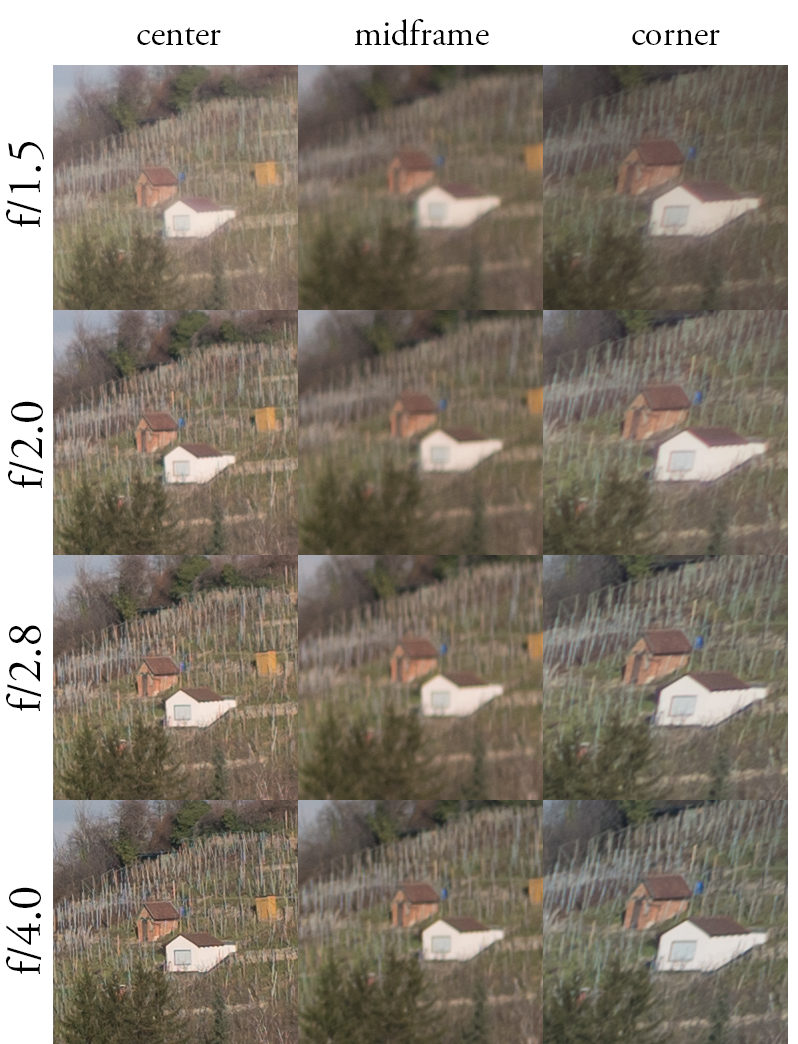
Description: When you shoot a flat scene there is a dip in resolution/contrast in a part of the frame, e.g. the midframe area or the corners. In the example above you can see a lens that has higher corner resolution than midframe resolution.
Common problem in: wide angle lenses, some fast lenses
Solution: stopping down will usually reduce the field curvature. With some lenses focusing on the midframe instead of the center can also improve results.
Trivia: when taking a picture of a uniform yet structured surface you can use the “find edges” filter in Photoshop to make the shape of the field curvature visible.

Vignetting
Light Falloff
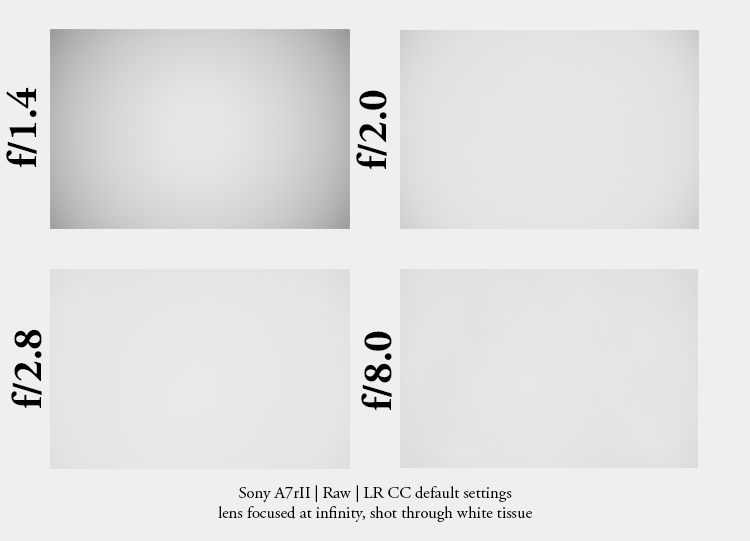
Description: Lower exposure in the corners compared to the center of the frame.
Common problem in: wide angle lenses, fast lenses
Solution: with most lenses stopping down will reduce the light falloff (with very small lenses there are sometimes only minor improvements)
Corner exposure can be lifted in post processing e.g. in Lightroom. For common lenses there are profiles available. Correcting this in post can lead to increased noise in the corners!
Trivia: on digital sensors some lenses (especially those with a small rear element close to the sensor) show increased light fall off due to “pixel vignetting” caused by the light rays hitting the sensor at an acute angle.
Optical Vignetting

Description: the shape of out of focus light circles deteoriates towards the corners of the frame, so instead of circles you see shapes that resemble cat’s eyes.
Common problem in: (small) fast lenses
Solution: none (except for maybe buying a lens where this is less pronounced)
Stopping down you will eventually get a perfect circle at some point, but then you are shooting at e.g. f/2.8 instead of f/1.4.
Trivia: also often referred to as “mechanical vignetting”
Color Cast
Description: The corners of the frame take on a different color than the rest of the frame.
Common problem in: small wide angle lenses, especially mirrorless/rangefinder designs
Solution: correct it with the third party software “corner fix” or use flat field correction/gradients in Lightroom, for more details have a look at this article
Trivia: this is not exactly a lens aberration but rather the inability of digital sensors to capture light that hits them at a very acute angle.
Spherical Aberration
Description:
undercorrection: loss of contrast and resolution (“glow”) across the whole frame
overcorrection: harsh bokeh with severe outlining
Common problem in: fast lenses (especially old ones) at maximum aperture
Solution: stopping the lens down by 1 stop usually makes a big difference
Trivia: for portraits a bit of undercorrected spherical aberration can be beneficial to give a smoother more flattering look
Chromatic Aberrations
Lateral CA
Crop from corner region of the frame
Description: the different color channels show different distortion patterns. Usually this leads to outlining on edges of high contrast that gets stronger the farther you move away from the center.
Common problem in: wide angle lenses, older tele lenses without ED elements, most zoom lenses.
Solution: in most cases this can be losslessly corrected in post. Stopping down does not make a difference to this aberration.
Trivia: Some lenses with a symmetrical optical design show zero lateral CA.
Longitudinal CA
Description: Longitudinal chromatic aberrations come in different forms where the most common are purple fringing (it shows up close to the plane in focus) and the “bokeh-CA” or “bokeh fringing” which you will see in the out of focus areas.
Common problem in: fast lenses
Solution: stopping the lens down will reduce this. You can also try to correct it in post, but this will not always work well enough.
Trivia: Some lenses that carry an “APO”-tag are perfectly corrected for this aberration and won’t show any colorful outlining at all.
Coma
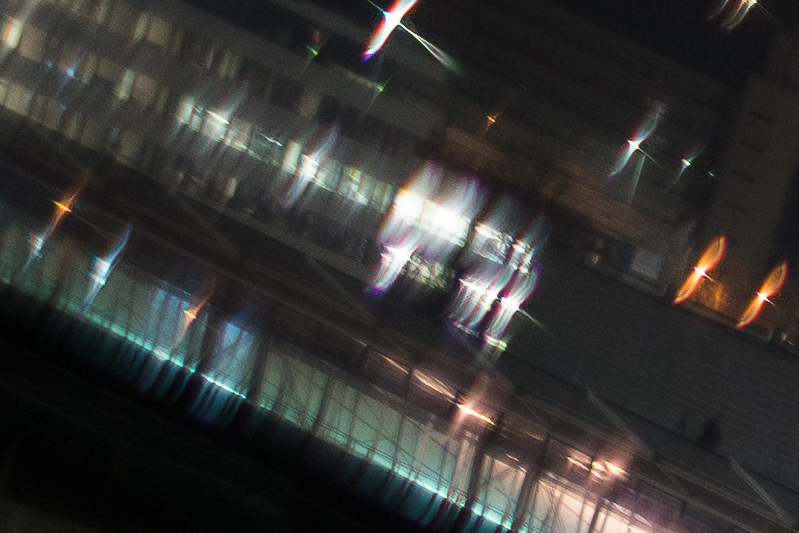
Description: small point light sources in the corners of the frame are not rendered as points but take on weird shapes instead.
Common problem in: fast wide angle lenses
Solution: stopping the lens down will reduce this
Trivia: if you are into astrophotography you should care about good coma correction.
Astigmatism

Description: away from the center structures show double edges which are either radially or tangentially oriented.
Common problem in: fast lenses, wide angle lenses
Solution: usually improves on stopping down.
Trivia: it can be difficult to distinguish between astigmatism and coma.
Focus Shift
Description: When you stop a lens down the plane of optimal focus shifts to the front or the back.
Common problem in: fast lenses
Solution: first stop the lens down and then focus. Often it also helps to just use f/8.0 to f/11 for this not to be a problem anymore.
Trivia: classic Sonnar lenses are known to show a notorious amount of focus shift.
Onion ring bokeh
Description: out of focus light circles show onion-ring-like patterns.
Common problem in: some fast lenses with aspherical elements
Solution: none except for buying a lens without these issues.
Flare resistance
Ghosting


Description: colorful artifacts (circles, crescents) in the frame
Common problem in: wide angle lenses, zoom lenses, lenses with high element count and big front elements
Solution: stopping down may change the shape and size of the artefacts. Slight reframing can sometimes help as well.
Internal reflections

Description: ring-like aberration (see picture)
Common problem in: a few very fast wide to normal lenses
Solution: stopping down can sometimes help here
Veiling flare
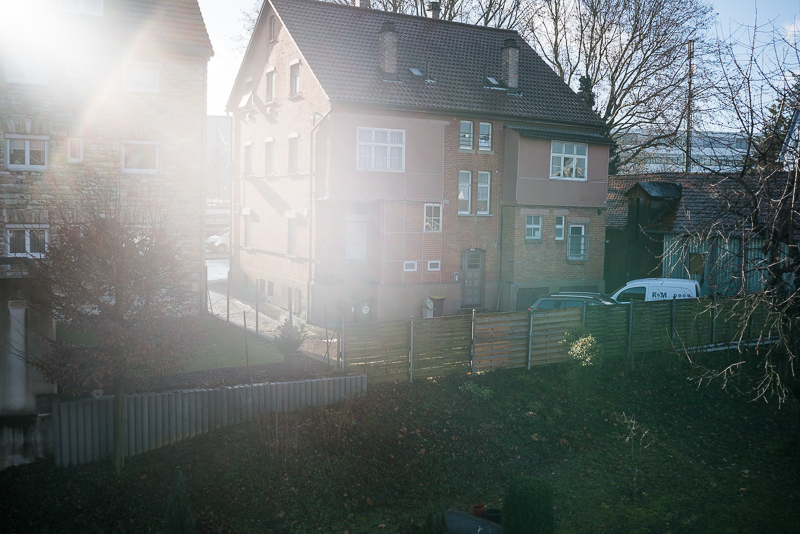
Description: almost the whole frame is covered by a veil of light that takes away most of the contrast
Common problem in: most severe in tele lenses
Solution: sometimes using the hood can help a bit
Further Reading
- Sony FE lenses: Our comprehensive and independent guide
- Guide to Ultra Wideangle lenses for Sony FE
- Bokeh Explained
- Review: MSOptics 135mm 2.4 Aporis
Support Us
Did you find this article useful or just liked reading it? Treat us to a coffee!
![]()
![]()
![]() via Paypal
via Paypal
Latest posts by BastianK (see all)
- Analogue Adventures Part 42: A wedding with Eastman Double-X 200 - July 2, 2025
- Vivo X200 Ultra – The Death of the compact Camera - June 29, 2025
- Review: Laowa 12mm 2.8 AF - June 26, 2025

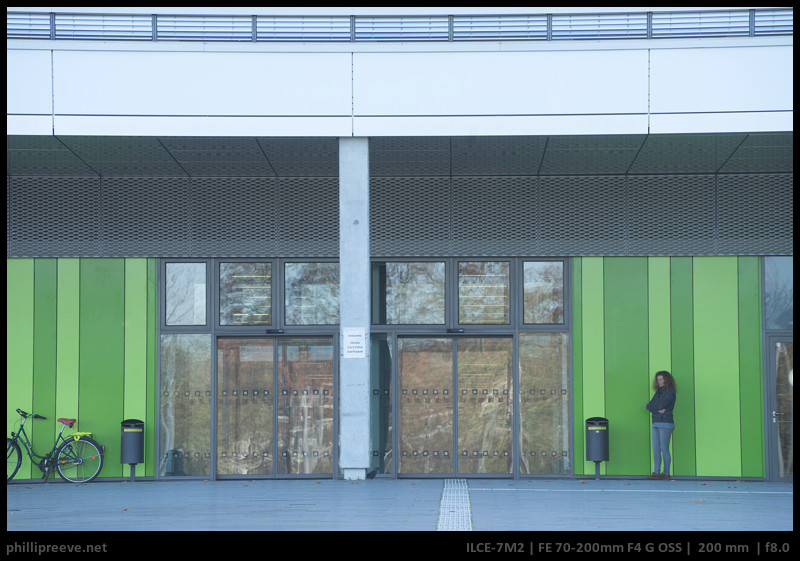



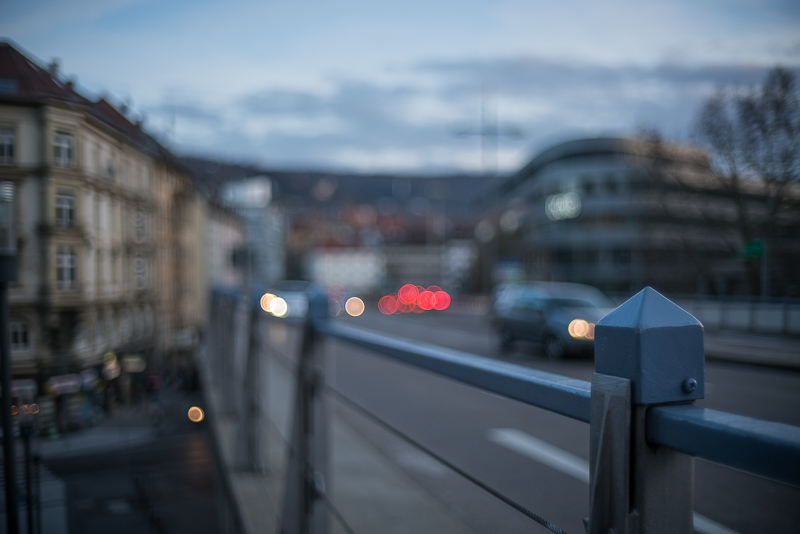

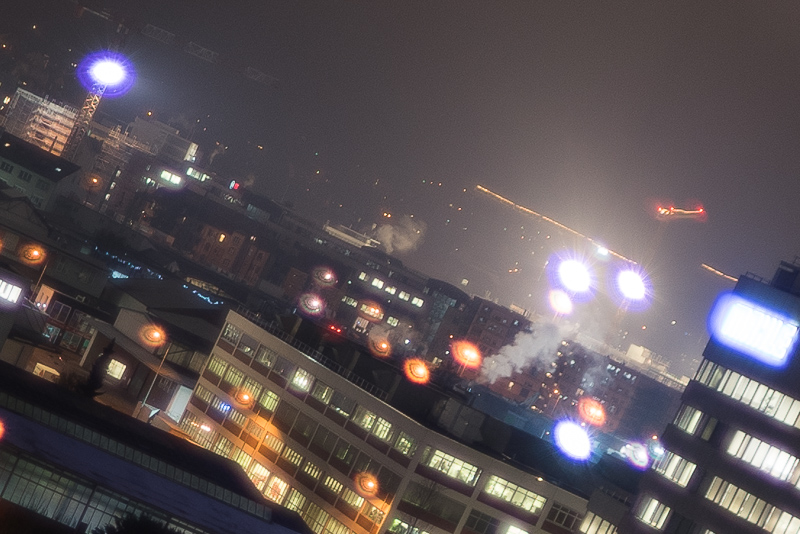





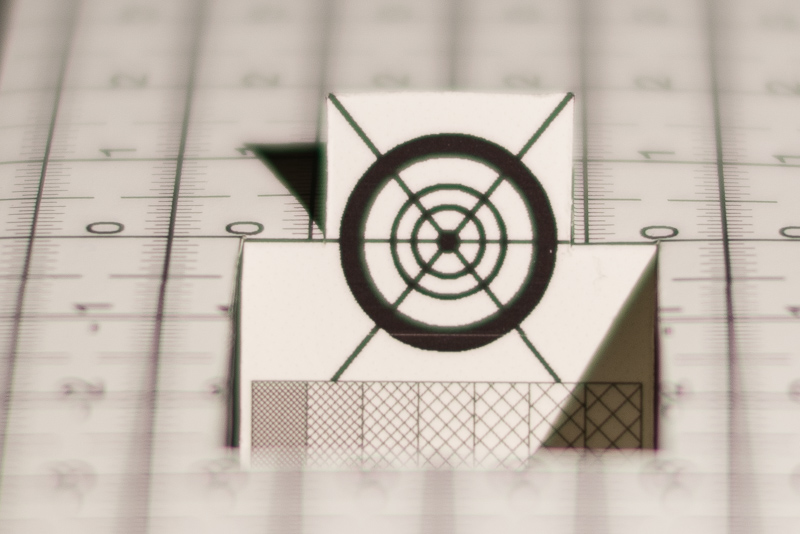

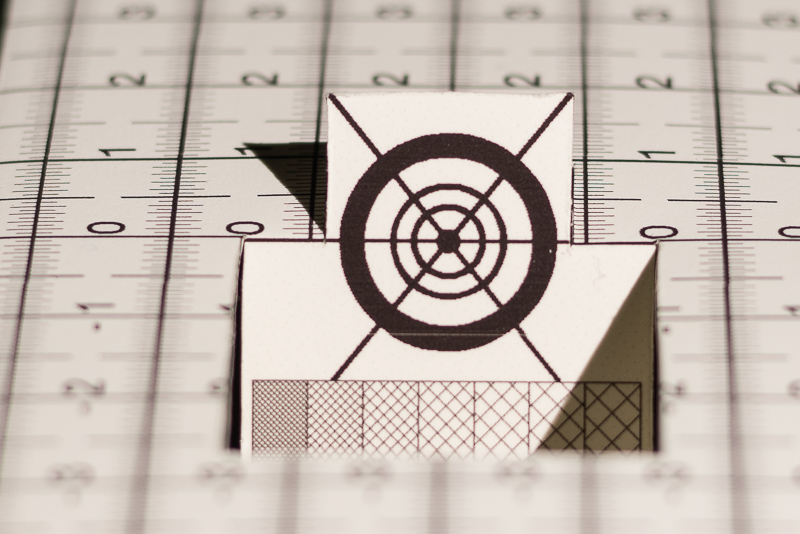
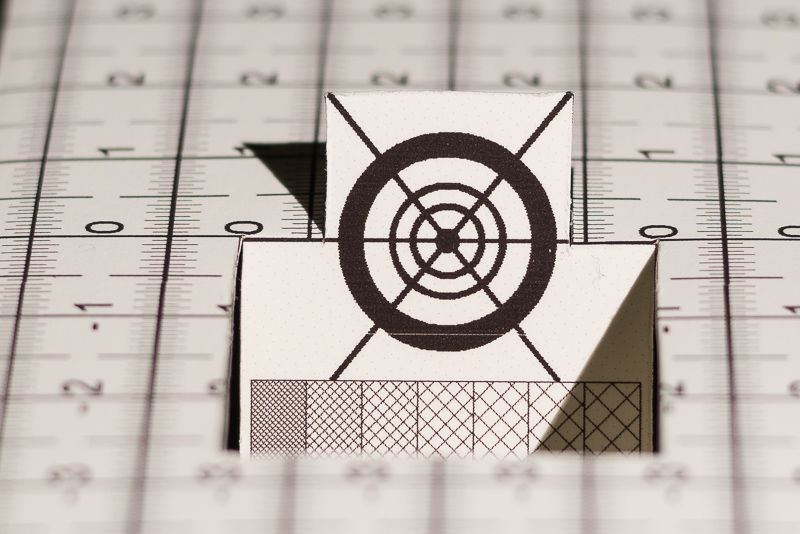


Great roundup. I think you’ve covered everything.
Few notes:
• Most of the aberrations (CA, astigmatism, coma, vignetting) are often non-uniform and greatly increase towards the corners. At least for web sized pics cropped (relative to lens image circle) sensors might care less.
• Color cast can cover the whole frame. I think several people on the team have Canon FDn 50/1.4 which wide open often gives uniform purple cast over the whole frame. I think the physics behind it is different from the corner cast, but it is still a thing.
• Veiling flare for adapted lenses depends on adapter and sensor behind the lens.
Thanks for the overview, but I think you might have mixed up LoCA and LaCA:
https://www.image-engineering.de/library/technotes/750-longitudinal-and-lateral-chromatic-aberration
No, I didn’t.
So is the article wrong? Or am I misunderstanding it?
Under LaCA: “This kind of aberration does not lead to colored areas, but to fringes that occur around objects of high contrast as the magnification is dependent on the wavelength.”
“Does not lead to colored areas” is not exactly a great description.
Yes, that’s right.
I’d like to post another link:
https://photographylife.com/what-is-chromatic-aberration
If you compare the tree image under LoCA and the test chart image under LaCA, you can see that both types of CA can look similar. Maybe that’s why I was confused about it. The only way to find out, which CA is present, is to stop down, because LaCA will stay.
That’s also what you wrote in your article. So sorry for the hassle, your didn’t mix it up. 🙂
There are some interesting lenses like the Nikon AF-S 24-120mm f/4.0 where the laCA do interesting things and seem to also be lower when stopping down.
But those are a really rare exception.
Very useful compendium. Thanks.
I have paid careful attention over the years to reviews like those you post to ensure that I avoid lenses that have built in problems that are difficult to correct (LOCA, a tendency to veiling flare and reflections, field curvature).
I especially like the Zeiss Batis 135mm in particular, though I like the Sony 28mm f/2 as well. I that I had been more savvy before buying the 55mm f/1.8, though (I failed to read your review in that instance).
It is competent and light and okay with my A7R2, but the onion rings grate (and the bokeh, while generally pleasing, is often busy.
Thank you for this. It’s simple, clear, and very helpful.
Great informative article for newcomers, thank you!
Does the infamous reflection from the sensor in older Sony designs fall into this category?
Ah, good point…
I will think about adding it!
Wonderful explanation to learn about various issues that we encountered, but do not know its terminology and meaning.
Really appreciate this article. It clarifies a lot of things that I see in my Takumars and other film-era lenses and makes it clear what can be corrected for and what we just have to live with. Looking forward to a follow-up article or two.
What lens is the color cast photo taken with?
I really like the rendering and sense of space.
Voigtländer VM 28mm 2.0 Ultron.
Thanks!
Clear, easy-to-digest article, should clear up a few users’ misunderstandings. I like that first photo of the pinetreeling and the lit funky bokeh behind it. Looks pretty stellar, like the MC 28/2’s : )
That was one of the main reasons to put it together: to have an easy to understand resource that can be linked to to clear up confusion 😊
Title picture has been taken with the Jupiter-3 50mm 1.5 @ f/1.5. I think every aberration is there 🤣
I always though that Color cast comes from coatings of the lens. And one of the quickest ways to fix it is shifting WB setting.
Also, the lenses with old designs usually have this color cast issue, because those designs were developed for film cameras, so glass coatings were different. Most of the time you will see harsh yellow/green color cast, compared to the modern lenses.
I do believe that the glass elements with different coatings are at fault here.
The color cast you are talking about is visible across the whole frame, not only in the corners.
Often (but not always) Auto White Balance will already take care of this.
Yes indeed, indeed this is only on the corners
Thank you, a very helpful Artikel.
A nice roundup, thank you!
Noted that different color renderings are not included in the list. I don’t see that as a serious omission though.
There is no disagreement about some lenses producing warmer colors than some others. Sometimes however there are strong opinions about the color characteristics of a specific lens, but I think those are mostly subjective opinions without rigorous research.
Scientifically thinking, it can be assumed that different glass types can act as filters, blocking certain wavelengths more than others. But I don’t know how the lens could change the wavelengths of the light going through it. The colors in an images are the result of a complex phenomenon that depends on many things, including the spectrum of the light, the reflective spectrum of the object, and the sensor. So, a few sample photos really can’t tell everything about how a lens handles colors.
indeed lenses could be blocking some of the colors also there is sensor/processor programming and it also effects the colors greatly, so if the lens is different the sensor gets different amounts of different colors, there fore sending different kind of information to the processor and processor makes the image according to the information that it got, the sequence is something like that. Depending on how it is programmed and how it “understands” the colors we get the results, that`s why modern lenses got the “color profiles” even in cameras so the images looks stunning with proper contrast, colors and clarity, but if we could adapt them to the early cameras that can not understand those color profiles, I wonder how the images would look on them 🙂
a. I would like to add mine to all previous expressions of gratitude to you all. This and FM are reliably and always the 2 most interesting photo-related sites in all of history. Thank you!
b. Not to complain, but when might we expect as comprehensive an article on “Lens-reviewers’ aberrations”?
Best wishes from Texas.
Reg. b.: that would be a lengthy article 🙂
But I will use the opportunity to point out 2 resources I personally find reliable and often use as a reference/to double check my findings:
Lenstip and Cameralabs.
Very complete and understandable article. Great job as usual.
great overview!
Not really worth including because its proabably very rare, even in old glass, is hotspots.
Both the Canon FD 17mm f4 and 20mm f2.8 often show a hotspot in the middle in high cotrast situations, which is annyoing very hard to correct.
https://www.flickr.com/photos/96189377@N08/16656221562
Yes indeed, hot spots information especially vital in infrared photography.
I can appreciate the work on explaining. I am optical engineer myself and I tend to explain such concepts from time to time .
Well put together, and pretty complete collection!
One of the most common aberrations that help with is the “finger oil” on lenses. Especially for cellphones or small diameter lenses. The images are less sharp especially with incoming light source (at night). That’s easy to fix by wiping the smudges from the lens.
Will you talk of the affect of mold/fogged lens on images?
Indeed that is a major issue with smartphone lenses, it may also lead to a plethora of lens flares.
For foggy/hazy lenes I would like to have 2 perfect examples lenses: one with and one without.
Unfortunately this is not the case so far.
It might also better fit a “common issues in used lenses” articles, together with loose mechanics
and too slow aperture blades.
This was such a fantastic read. Any plans for Part II?
Ah not any time soon I fear.
Thank you excellent
Highly informative good overview,
For some deep background about optics I can recommend this link:
https://www.telescope-optics.net/index.htm
Yes it is about optics, but it shows a lot about optical design and optimize for abberations. Optical designers should also be rewarded to get a good corrected lens with as little as possible lens-elements and a design that is less vulnerable to fabrication errors depending the specific goal of a lens. Sounds strange but a simple 5 element Ernostar design with one ED element performes great as an astrolens when stopped down a third of a stop, the Nikkor AIS ED 180mm f2,8. Yep wide-angles are more difficult… a flexy curved sensor will help optimizing lenses, costs and element.
Thank you very much, very comprehensive.
I missed one…, Sunstars. .., you like them very much, but they are not what I see bare eyes, so for me its an aberration.
Another interesting link about optical design:
https://www.pencilofrays.com/lens-design-forms
Wonderful article!
Question: does field curvature not also impact the area of focus, as opposed to just contrast and resolution?
Actually because it affects the area of focus resolution and contrast are reduced.
Well done, especially your example pics.
Having participated in the development of lenses myself and also measuring them in Ulbricht-Spheres I would add two things:
– Vignetting is unavoidable with all lenses and is ruled by the cos4 law!
– ‚cats eyes’ is also unavoidable and can be comprehended simply by looking through a toilet roll and moving it parallel of axis from your vision.
I will never understand why people keep ranting over these things in all of the lens reviews?!
If the image circle of the lens is big enough (as in: uneconomically big) there are no cat’s eyes, so claiming this is unavoidable is simply wrong.
Or to make it more simple: your toilet roll just needs a bigger diameter.
As I have shown there are big differences between lenses with arguably the same specs.
Probably that is the reason people are interested about these differences.